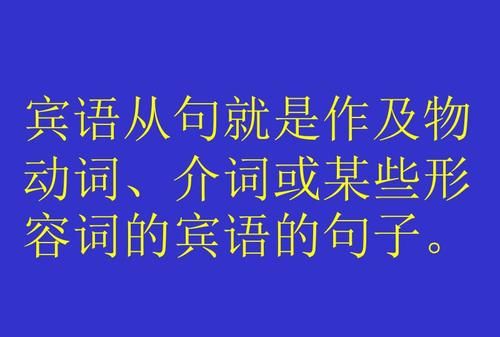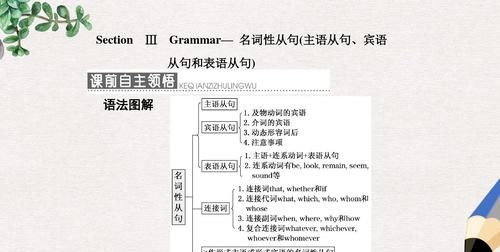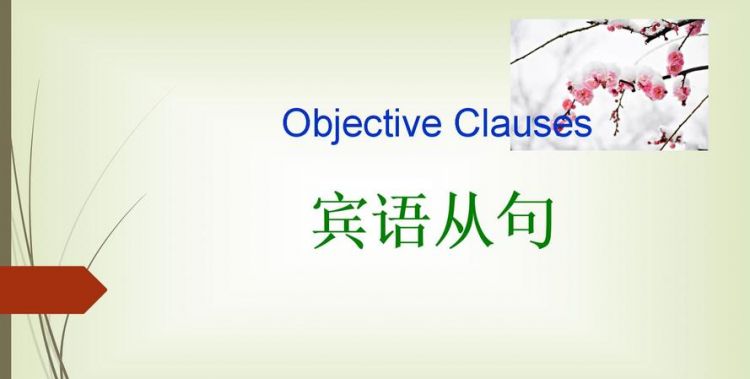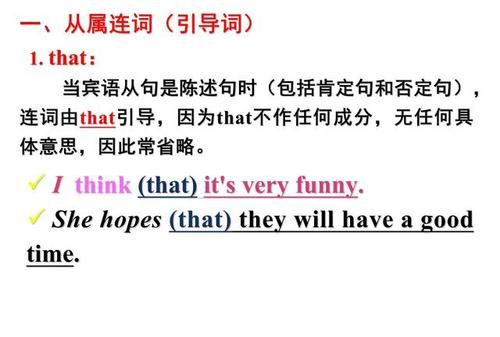本文目录
英语中的谓语,宾语,表语从句都是什么
分类: 教育/科学 >> 外语学习
解析:
定 语 从 句
一、 限定性定语从句
1. that即可代表事物也可代表人,which代表事物;它们在从句中作主语或宾语,that在从句中作宾语时常可省略关系词,which在从句中作宾语则不能省略。而且,如果which在从句中作“不及物动词+介词”的介词的宾语,注意介词不要丢掉,而且介词总是放在关系代词which的前边,但有的则放在它原来的位置
1) The first doll say “mama”was invented in 1830.
〔A〕 that it could
〔B〕 could it
〔C〕 it could
〔D〕 that could
2) A solar day is the length of time the Earth to revolve once around the Sun.
〔A〕 takes
〔B〕 takes it
〔C〕 which takes
〔D〕 he takes
3) The period during when 〔A〕 people learned 〔B〕 to melt iron is called 〔C〕 the 〔D〕 Iron Age.
2. which作宾语时,根据先行词与定语从句之间的语义关系,先行词与which之间的介词不能丢
4) The second half of his voyage was by far the more dangerous part, he sailed round the treacherous Cape Horn.
〔A〕 where
〔B〕 of which
〔C〕 during which
〔D〕 that
5) To travel from England to Hope Corn had taken him nine months, the sailing time was 226 days. He had done what he wanted to acplish.
〔A〕 when
〔B〕 which
〔C〕 of which
〔D〕 that
3. 代表物时多用which,但在带有下列词的句子中用that而不用which,这些词包括all, anything, much等,这时的that常被省略(见本节“四、关系代词的省略”)
4. who和whom引导的从句用来修饰人,分别作从句中的主语和宾语,whom作宾语时,要注意它可以作动词的宾语也可以作介词的宾语
6) Henry Ford is the person 〔A〕 which 〔B〕 is most responsible 〔C〕 for developing 〔D〕 the idea of mass production.
7) Human beings are social 〔A〕 animals whom 〔B〕 usually prefer not to live in 〔C〕 physical or psychological isolation 〔D〕 .
5. where是关系副词,用来表示地点的定语从句
8) The Everglades is a beautiful region of southern Florida the primitive past mingles with modern life.
〔A〕 there
〔B〕 where
〔C〕 after
〔D〕 in
9) The knee is the joint the thigh bone meets the large bone of the lower leg.
〔A〕 when
〔B〕 where
〔C〕 why
〔D〕 which
10) A metropolitan region 〔A〕 is defined as a central 〔B〕 city and the territory where 〔C〕 surrounds 〔D〕 it.
6. when引导定语从句表示时间
11) The next morning he came down to breakfast, he was beaming with the pleasure of a new, great discovery.
〔A〕 as
〔B〕 when
〔C〕 because
〔D〕 that
12) In a day few noble persons ever spoke to those of humble origins except to give an order, Jefferson went out of his way to talk with gardeners, servants, and waiters.
〔A〕 whose
〔B〕 during
〔C〕 when
〔D〕 of
13) Moreover, in the modern age human beings depend so much on machines, he had given men throughout the world new pride.
〔A〕 when
〔B〕 whether
〔C〕 more
〔D〕 ever
〔注〕 值得一提的是,表示时间“time”一词的定语从句只用when引导,有时不用任何关系代词,当然也不用that引导
By the time you arrive in London, we will have stayed there for o weeks. / I still remember the first time I met her. / Each time he goes to besiness trip, he brings a lot of living necessities, such as towers, soap, toothbrush e
7. whose是关系代词,修饰名词作定语,相当于所修饰成分的前置所有格
14) There was a teapot fashioned like a China duck out of open mouth the tea was supposed to e.
〔A〕 which
〔B〕 its
〔C〕 that
〔D〕 whose
15) Jackir Mcleans’s recordings have shown that he is one of the few 〔A〕 jazz musicians who 〔B〕 style of playing 〔C〕 has kept pace with the evolution 〔D〕 of modern jazz.
8. 当从句的逻辑主语是some, any, no, somebody, anybody, nobody, something, anything, everything或nothing时,常用there is来引导
16) I don't want to concentrate on anything worrying me.
〔A〕 what is
〔B〕 there is
〔C〕 what
〔D〕 there
二、非限定性定语从句:非限定性定语从句的作用是对所修饰的成分作进一步说明,通常和主句间用逗号隔开,将从句拿掉后其他部分仍可成立
1. which引导的非限定性定语从句来说明前面整个句子的情况或主句的某一部分
2. 在引导限定性定语从句时,that有时相当于in which, at which, for which或at which
Attitudes towards daydreaming are changing in much the same way that(in which) attitudes towards night dreaming have changed. 人们对白日做梦的态度正在改变,这与人们对夜间做梦的看法的变化有非常相似之处。
I like the music for the very reason that(for which) he dislike it. 我出于某种原因喜欢这种音乐,而他恰恰与我相反。
We arrived the day that(on which) they left. 刚好我们到的那天他们走了。
3. 有时as也可用作关系代词
4. 在非限定性定语从句中,不能用that,而用who, whom代表人,用which代表事物
17) Ligaments(韧带), , hold ans of the body in place and fasten bones together.
〔A〕 which are fibrous tissues
〔B〕 they are fibrous tissues
〔C〕 fibrous tissues that
〔D〕 are fibrous tissues
18) The Little White House in Warm Springs was the Geia home of President Franklin D. Roosevelt, there on April 12, 1945.
〔A〕 who died
〔B〕 died
〔C〕 while died
〔D〕 he died
19) The first United States citizen to bee 〔A〕 a professional 〔B〕 sculptor was Patience Lovell Wright, which 〔C〕 works were executed in wax 〔D〕 .
三、定语从句结构错误
1. 缺关系词
20) The adder is a snake has 〔A〕 a relatively 〔B〕 stout body, a short tail 〔C〕 , and a flat head 〔D〕 .
2. 从句中缺成分
21) Traditionally, ethnographers and linguists have paid 〔A〕 little attention to cultural interpretations given to 〔B〕 silence, or to 〔C〕 the types of social contexts in which tends 〔D〕 to occur.
四、连接代词的省略
22) Most crocodiles will eat anything capture and overpower.
〔A〕 can
〔B〕 they can
〔C〕 which can
〔D〕 and
五、例题解析
1) D为正确答案。本句中的主句为“The first doll was invented in 1830”,“that could say ‘mama’”为定语从句,修饰主句中的名词(主语)“the first doll”。
2) C为正确答案。
3) A错。during是介词,它后面的关系代词只能用which(指人除外),which在此处指代“the period”,定语从句为“during which people…iron”,修饰主句的主语“the period”。
4) C为正确答案。
5) C为正确答案。
6) B错。改用who,which只能指物,指人时应用who,本句的定语从句修饰the person,关系代词who在从句中作主语。本句也可改用that,因为that也可用来指人,它可在从句中作主语或宾语,但which则只能指“物”。
7) B错。应改用who,因为这里所指代的是“human beings”,而且在从句中作主语,而whom只能用来作宾语。
8) B为正确答案。空白后是一个定语从句,从句中主谓宾齐全,关系副词where指代上面表示地点的名词region(地方,地区),相当于in which,即in the region,在从句中作地点状语。
9) B对。空白后为定语从句,从句中的主谓宾语都已齐全,where作从句中的地点状语,相当于in the joint,整个从句修饰“the joint”。
10) C错。改为which或that。这里是一个定语从句,修饰前面的the territory(区域),虽然被修饰成分表示一个地点,但若用where代替in the territory在从句中作地点状语,从句中便没有了主语,这显然不对。改用which后,便可由它作从句中的主语,代the territory;从句中的it代上文中的a central city。
11) B为正确答案。
12) C为正确答案。
13) A为正确答案。
14) D为正确答案。这里whose修饰名词短语“open mouth,” 这时“whose open mouth”一起作介词“of”的宾语。
15) B错。who应当在定语从句中作主语,而从句中已有主语style of playing(演奏风格),故应将who改为whose,用whose修饰style,指代上文中的人名,相当于his。
16) B为正确答案。
17) A对。空白处是which引导的定语从句修饰主句的主语ligaments,which作从句的主语,主句的主语(ligaments)和谓语(hold)被定语从句所隔开。
18) A对。本句是关系代词who引导的非限定性定语从句,who指代前面的被修饰成分President Franklin D. Roosevelt并在从句中作主语。
19) C错。应改用whose,修饰从句中的主语works,whose相当于his。
20) A错。本句已有谓语动词is,而后面又出现动词has,显然不合语法,故应在snake和has之间加上关系代词which或that构成定语从句修饰snake,which作从句的主语。
21) D错。本句“in which”中的which指代“social contexts”,which在从句中已经是介词in的宾语,这样从句中便没有了主语,故应在which后加代词it(代silence),即变为“in which it tends…”,用it作从句的主语,这样句子才完整。
22) B对。关系代词作限定性定语从句中的宾语时可以省略,本句被修饰词anything后就省去了“that”;C是不对的,首先,C中的which作从句的主语,而从句中的动词(作谓语)capture and overpower都为及物动词,可后面没有宾语,这样句子便不完整;其次,如果被修饰成分为不定代词(anything, all等),或修饰成分前有形容词最高级以及限定性较强的形容词修饰时(the very,the only,the same,the first,the last,the tallest),应使用关系代词that,而不用which。
宾语从句
1. 由连词that、疑问代词或副词(如how, why和where等)引出的宾语从句
2 介词后的宾语,其宾语可以是名词或代词,也可以是个句子,即宾语从句,也可以由“what”来引导
表语从句(predicative clause)
如This is what I want to say(这是我要说的)中的what I want to say。

英语的宾语从句
一.宾语从句的定义置于动词、介词等词性后面起宾语作用的从句叫宾语从句.宾语从句的语序必须是陈述语序.谓语动词、介词、动词不定式,v.-ing形式后面都能带宾语从句.有些形容词(afraid,sure,glad等)之后也可以带宾语从句.
二.宾语从句中引导词的用法在复合句中作主句的宾语,引导词有:连词:that (that 常可省略),whether, if
代词:who, whose, what ,which
副词:when ,where, how, why 等.
(一)that引导的宾语从句(在非正式场合that可以省略)可跟that从句做宾语的动词有:
say, think, insist, wish, hope, demand, imagine, wonder, know, suppose, see, believe, agree, admit, deny, expect, explain, order, command, feel, dream, suggest, hear, mean, notice, prefer, request, require, declare, report等.
例句:The boy believes that he will travel through space to other planets.
注意事项:当主句谓语动词是 think, believe, suppose, expect 等词,而宾语从句的意思是否定时,常把否定转移至主句表示.
例句:I don’t think it is right for him to treat you like that.
在以下情况中that不能省略当句中的动词后接多于两个由that引导的宾语从句时,第一个that可省,但后面的that不可省.
例句:He said (that) you were too young to understand the matter and that he was asked not to tell you.当主句的谓语动词与that宾语从句之间有插入语时,that一般不可省.
例句:Just then I noticed, for the first time, that our master was wearing his fine green coat and his black silk cap.当that从句是双宾语中的直接宾语时,that不可省.
例句:I can’t tell him that his mother died.
注意事项:当主句谓语动词是 think, believe, suppose, expect 等词,而宾语从句的意思是否定时,常把否定转移至主句表示.
例句:I don’t think it is right for him to treat you like that.
在以下情况中that不能省略当句中的动词后接多于两个由that引导的宾语从句时,第一个that可省,但后面的that不可省.
例句:He said (that) you were too young to understand the matter and that he was asked not to tell you.当主句的谓语动词与that宾语从句之间有插入语时,that一般不可省.
例句:Just then I noticed, for the first time, that our master was wearing his fine green coat and his black silk cap.当that从句是双宾语中的直接宾语时,that不可省.
例句:I can’t tell him that his mother died.注意事项:许多带复合宾语的句子,that引导的宾语从句经常移到句子后部,而用it作形式宾语.
例句:I find it necessary that we should do the homework on time.
(二)由whether,if 引导的宾语从句由whether(if)引导的宾语从句,实际上是一般疑问句演变而来的.意思是“是否”.宾语从句要用陈述句语序.一般说来,在宾语从句中whether与if可以互换使用,但在特殊情况下if与whether是不能互换的.
例句:I wonder whether(if) they will come to our party.
只能用whether,不能用if引导的宾语从句在带to的不定式前
例句:We decided whether to walk there.
在介词的后面
例句:I’m thinking of whether we should go to see the film.在动词后面的宾语从句时
例句:We discussed whether we had a sports meeting next week直接与or not连用时
例句:I can’t say whether or not thet can come on time.只能用if不能用whether引导的宾语从句if引导条件状语从句,意为“如果”
例句:The students will go on a picnic if it is sunny.
if引导否定概念的宾语从句时
例句:He asked if I didn’t come to school yesterday.引导状语从句even if(即使)和as if(好象)时
例句:He talks as if he has known all about it.
(三)连接代词和连接副词引导的宾语从句这样的宾语从句实际上是由特殊疑问句变化而来的,宾语从句要用陈述句语序.用于这种结构的动词常常是:see, say, tell, ask, answer, know, decide, show, find out, imagine, suggest, doubt, wonder, discover, understand, inform, advise等.
英语中的连接代词有:who,whom,whose,which,what,在句中担任主语、宾语、定语或者表语.
例句:Can you tell me whom you are waiting for?
英语中的连接副词有:when,where,why,how,在句中担任状语的成分.
例句:None of us knows where these new parts can be bought.
三.宾语从句的语序宾语从句的语序是陈述句语序即:连接代词/副词+主语+谓语+其他成分.例句如下:
I don’t know what they are looking for.Could you tell me when the train will leave?Can you imagine what kind of man he is?
四.宾语从句的时态主句是一般现在时,从句根据实际情况使用任何时态.
例句:The headmaster hopes everything goes well.主句是过去时态,从句须用过去时态的某种形式.
例句:She was sorry that she hadn’t finished her work on time.当宾语从句表示的是一个客观真理或者事实时,即使主句是过去时,从句也用一般现在时态.
例句:The teacher told his class that light travels faster than sound.
五.宾语从句的特点宾语从句可以作及物动词、介词及形容词的宾语.宾语从句的语序一律用陈述句语序.连接词that引导宾语从句在句中无词义,不充当句子成份,多数情况下可以省略.whether 和 if 都可引导宾语从句,但 whether后可紧跟or not;whether从句可作介词的宾语.如果从句太长,可以用形式宾语it.

在英语中什么样的句子叫宾语从句呢
宾语从句和表语从句可以统一称作名词性从句。
宾语从句顾名思义就是一个作宾语的句子,
例如:
I believe that he lied to us.
这里that he lied to us就是宾语从句,作believe的宾语。
表语从句就是作表语的句子(跟在系动词be/remain/seem等后面)
例如:
My question is how I can get there.
这里how I can get there就是表语从句。
定语从句可以看做一个修饰名词的形容词,
例如:
Do you know the girl who is talking to Mary over there?
这里who is talking to Mary over there就是定语从句修饰the girl

关于英语宾语从句的思维导图
宾语从句的点点滴滴
宾语从句是英语复合句中的其中非常重要的从句之一。它是用一个句子做另一个句子的宾语,将这个句子叫做宾语从句。宾语从句做介词或及物动词的宾语。现在从下列三个方面总结归纳如下:
一,引导词
A,由that
引导的陈述句性的宾语从句,在很多动词如say,
think,
wish
,
hope,
see,
believe,
agree,
expect,
hear
,
feel等动词后。连词that只起连接作用,在从句中不做句子的成分,也无词汇意义,在口语中常被省略,但在大多数情况下还是以不省为好,特别是在笔语中。例:I
told
him
that
he
was
wrong.
在think,believe,
suppose,
expect等动词引起的宾语从句中,有时谓语尽管是否定意义,却不用否定形式,而将think
等动词变为否定形式。例:I
don’t
think
you
are
right.
(我认为你做的不对)
l在许多带有复合宾语的句子中,that引导的宾语从句经常移到句子的后面,而用it做形式宾语。
例:We
think
it
wrong
that
he
told
a
lie
to
everyone
(我认为他向每一个人撒谎是错误的)
B,由连词if、
whether
引导的表示“是否…”的宾语从句。Whether,if
在从句中不做句子的成分,一般情况下,whether和if
可以替换。例:I
don’t
know
if/whether
he
will
come
tomorrow.
在介词后面的宾语从句中不用if引导
例:Everything
depends
on
whether
we
have
enough
money。
宾语从句中有or
not时不用if引导.
例:I
don’t
know
whether
the
movie
star
will
come
or
not.
l和不定式连用作宾语时不用if引导.
例:Whether
to
go
there
or
not
hasn’t
been
decided.
C,由wh-引导的宾语从句。连接代词who,whom,whose,
what,
which,和连接副词when,
where,
why,
how
等连接的宾语从句,它们在句中即有连接从句的作用,又在句中充当句子的成分。
例:Do
you
know
which
film
they
are
talking
about?
(which做定语)
二,宾语从句的语序,
宾语从句从句的语序必须是陈述语序,既连接词+主语+谓语+其他成分
例:I
believe
that
they
will
come
soon.
三,宾语从句的时态。宾语从句的时态受主句的限制,既:主句是一般现在时态,从句根据实际情况而定。主句是一般过去时态,从句用相应的过去的时态。如果从句的动作发生在主句之前,则从句要用过去完成时态。例:1)She
says
that
she
is
a
student.
l如果宾语从句说的是客观真理、自然现象或事实时,这时宾语从句要用一般现在时态。
例:The
teacher
said
that
the
earth
goes
round
the
sun.
注意事项:u由陈述句变成宾语从句时,要注意人称的变化。例:She
said:
“I
have
been
to
England
before.”

以上就是关于英语什么句子可以作宾语从句,英语中的谓语,宾语,表语从句都是什么的全部内容,以及英语什么句子可以作宾语从句 的相关内容,希望能够帮到您。
